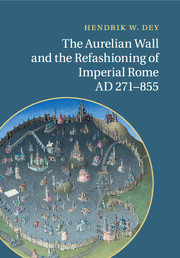Book contents
- Frontmatter
- Contents
- List of abbreviations
- List of figures
- Acknowledgements
- Introduction
- 1 Toward an architectural history of the Aurelian Wall, from its beginnings through the ninth century
- 2 Planning, building, rebuilding, and maintenance: the logistical dynamics of a (nearly) interminable project
- 3 Motives, meaning, and context: the Aurelian Wall and the late Roman state
- 4 The city, the suburbs, and the Wall: the rise of a topographical institution
- 5 Sacred geography, interrupted
- 6 The Wall and the “Republic of St. Peter”
- Conclusion
- Appendices
- Bibliography
- Index
5 - Sacred geography, interrupted
Published online by Cambridge University Press: 19 May 2011
- Frontmatter
- Contents
- List of abbreviations
- List of figures
- Acknowledgements
- Introduction
- 1 Toward an architectural history of the Aurelian Wall, from its beginnings through the ninth century
- 2 Planning, building, rebuilding, and maintenance: the logistical dynamics of a (nearly) interminable project
- 3 Motives, meaning, and context: the Aurelian Wall and the late Roman state
- 4 The city, the suburbs, and the Wall: the rise of a topographical institution
- 5 Sacred geography, interrupted
- 6 The Wall and the “Republic of St. Peter”
- Conclusion
- Appendices
- Bibliography
- Index
Summary
From the moment of its construction, the Aurelian Wall began markedly to affect the manner in which Romans lived and worked and moved, and thus to alter the physical contours of the city, as the previous chapter has, I hope, shown. It remains to be seen how the new fortifications came to affect the less tangible aspects of Rome's urban identity: the characterization and classification of urban space, and the body of convention, civic and religious – the two are effectively inseparable – that had long distinguished a city center which in reality transitioned quite imperceptibly into its surroundings. The following, then, is an attempt to explore how the Wall first altered and ultimately (re)created prevailing notions of urban boundaries, beginning under the last pagan emperors and continuing into the age of papal supremacy.
Along with these changed boundaries came new and different prescriptions for the use of territory on both sides of the line, above all in matters of sacred cult, which evolved beyond recognition in the first centuries of the Wall's existence. But for all that pagans and Christians took conspicuously different approaches to the distinction between urban and suburban space, and the activities appropriate to each sphere, they were nearly unanimous in their choice of the enceinte as the intervening threshold. As the clear and enduring separator between these “inner” and “outer” zones, the Wall gave physical form and context to a sequence of shifting religious and cultural paradigms that redefined the relationship between interior and exterior space, each of which was in turn privileged over the other.
- Type
- Chapter
- Information
- Publisher: Cambridge University PressPrint publication year: 2011



